Abstract
Objective:
To compare and contrast the relationships of selected static clinical measurements with the heel forces of forward and backward walking among healthy high school athletes.
Design and Setting:
Single-group, cross-order-controlled, repeated-measures design. All data were collected in a high school athletic training room.
Subjects:
Seventeen healthy high school student-athlete volunteers.
Measurements:
We performed static clinical measurements of the foot, ankle, and knee using handheld goniometers. We used a metric ruler to assess navicular drop and a beam balance platform scale to measure body weight. Mean peak heel forces were measured using F-scan insole force sensors. Data were sampled for 3 5-second trials (50-Hz sampling rate). Mean peak heel forces were determined from 3 to 5 consecutive right foot contacts during forward and backward walking at approximately 4.02 to 4.83 km/h (2.5 to 3.0 mph). Subjects wore their own athletic shoes and alternated their initial walking direction.
Results:
Forward stepwise multiple regression analyses revealed that body weight, navicular drop, and standing foot angle predicted mean peak heel forces during forward and backward walking.
Conclusions:
Heel forces during forward and backward walking increase as body weight and navicular drop magnitude increase, and they decrease as standing foot angle increases. Subtle differences in foot, ankle, and knee joint postures and kinematics can affect heel forces even among normal subjects. Injury and protective bracing or taping may further affect these heel forces.
Keywords: biomechanics, gait, goniometry, posture
Full text
PDF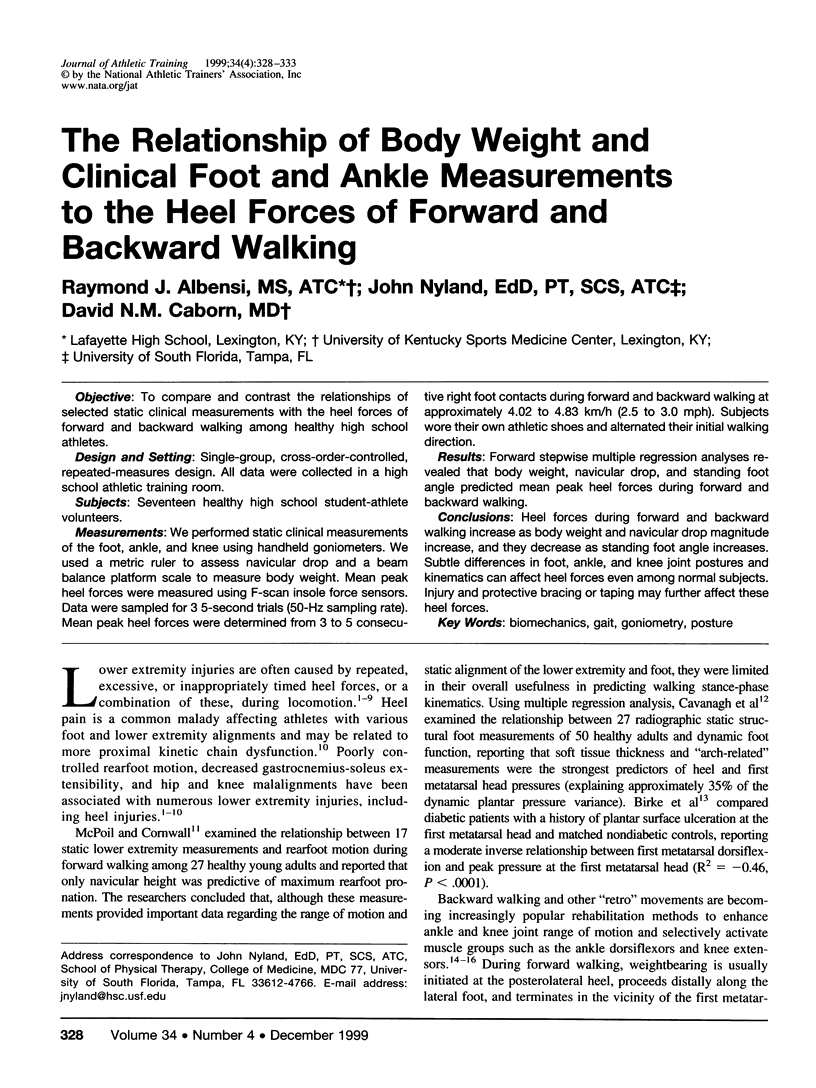
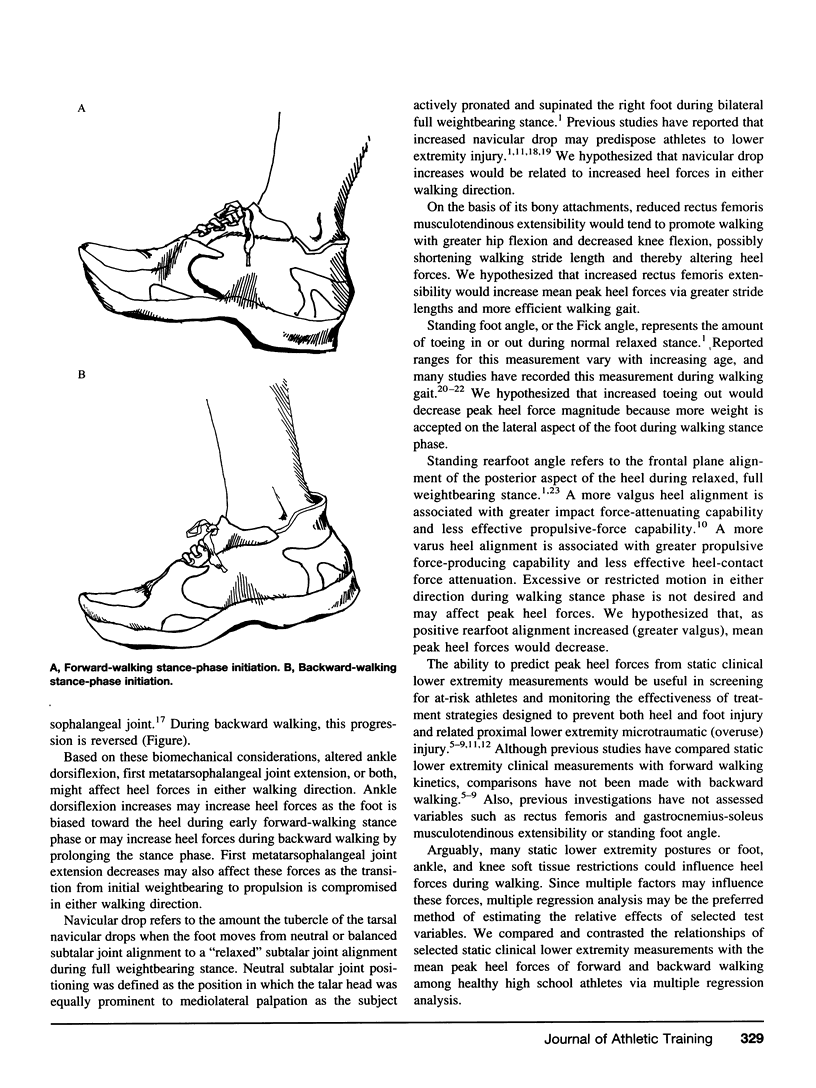
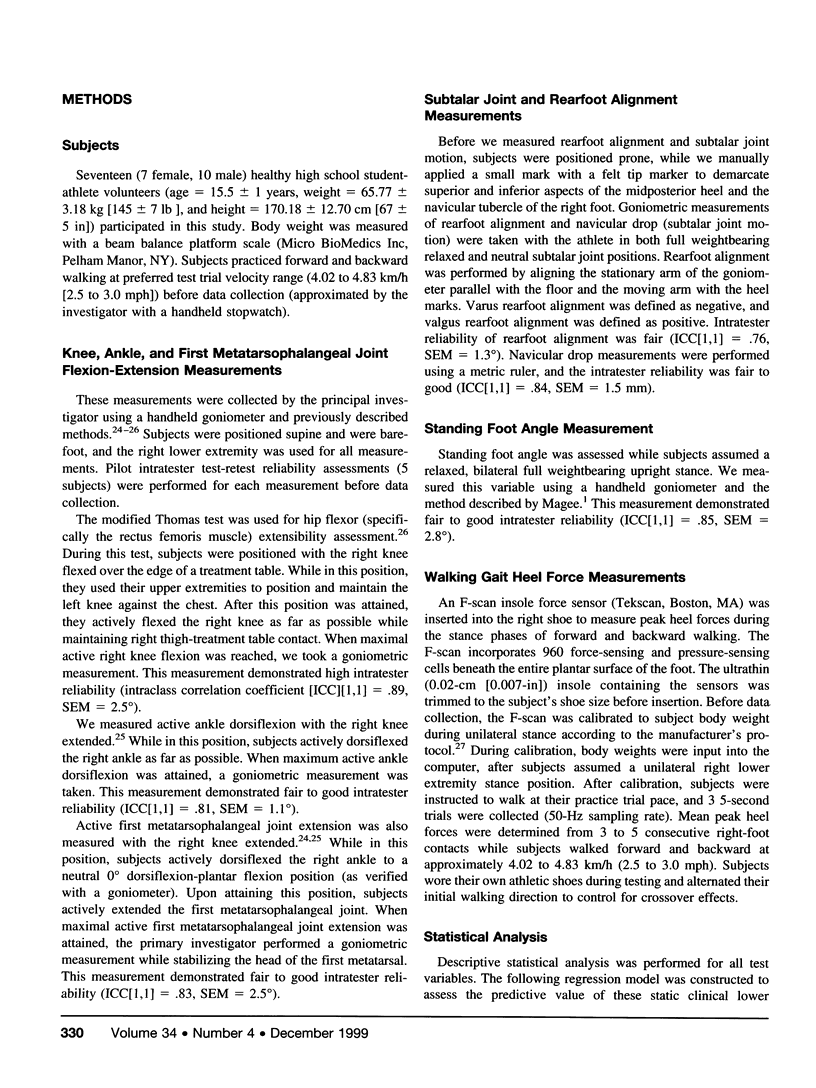
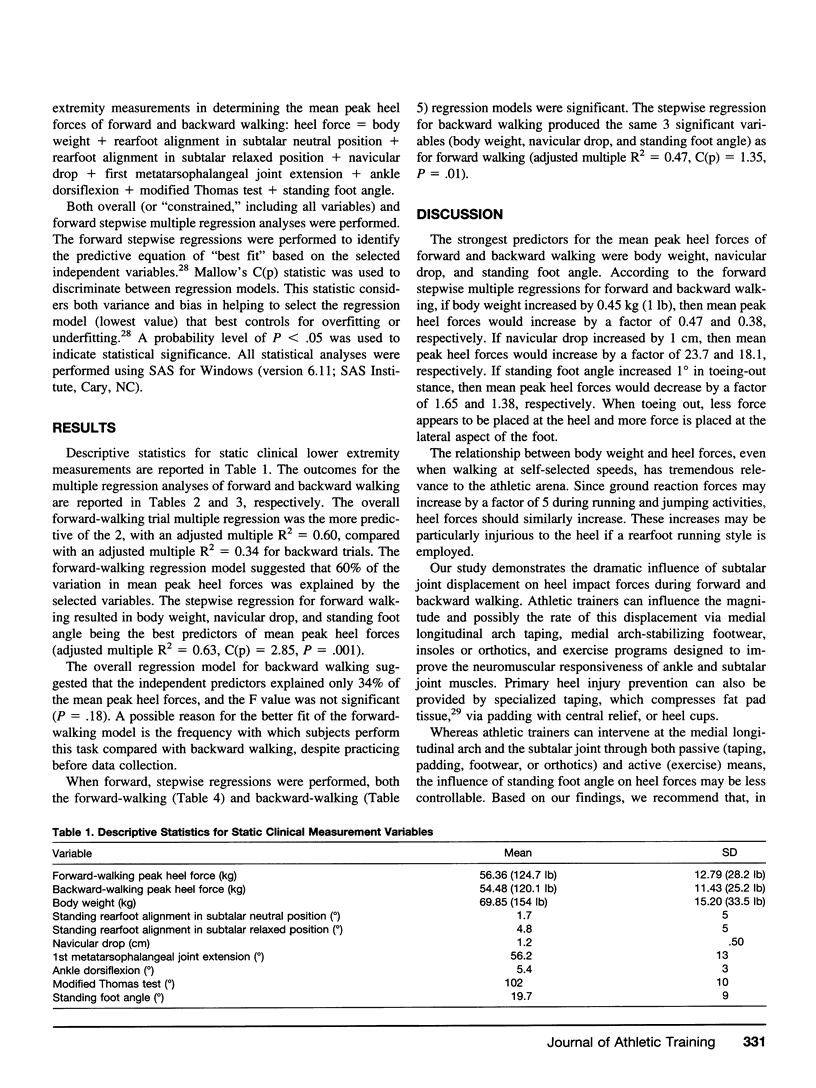
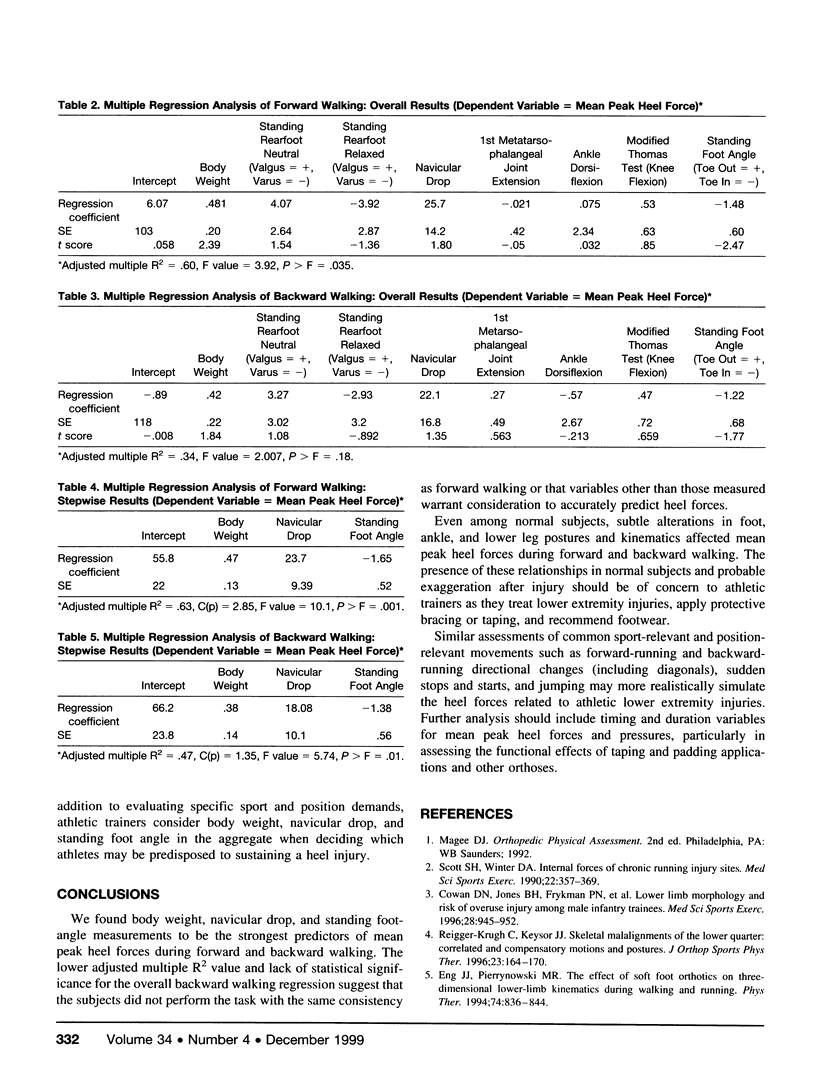
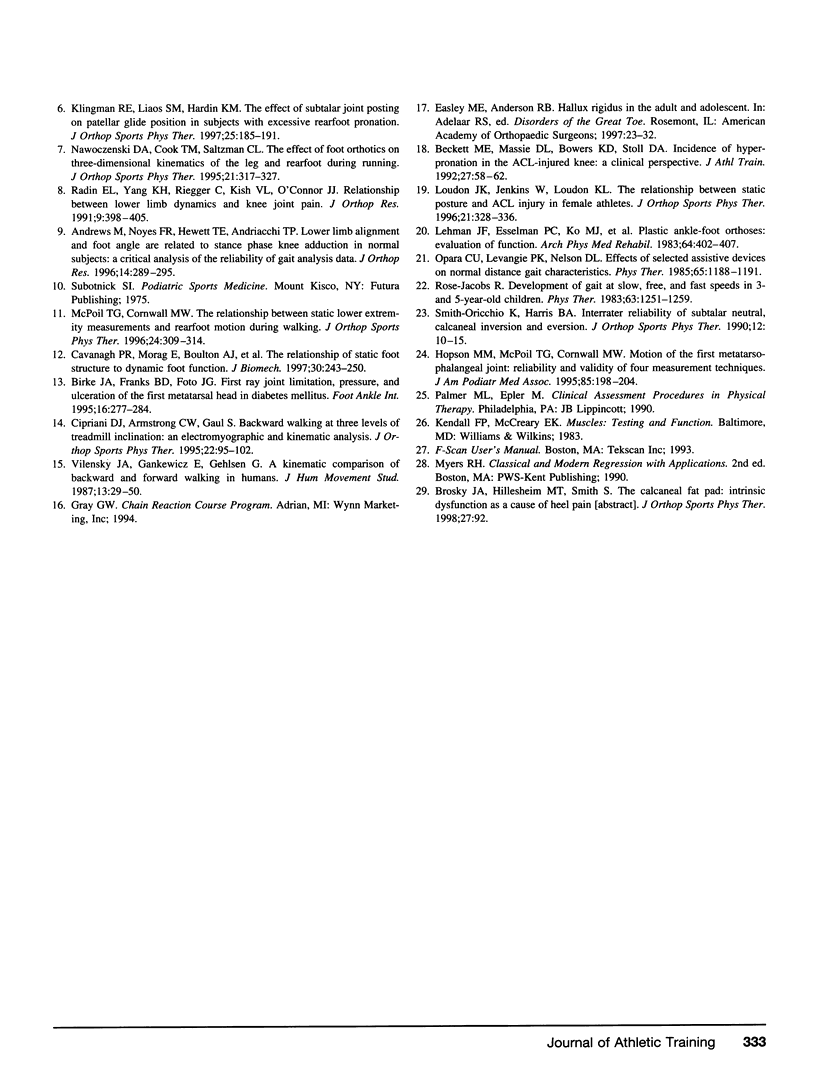
Selected References
These references are in PubMed. This may not be the complete list of references from this article.
- Andrews M., Noyes F. R., Hewett T. E., Andriacchi T. P. Lower limb alignment and foot angle are related to stance phase knee adduction in normal subjects: a critical analysis of the reliability of gait analysis data. J Orthop Res. 1996 Mar;14(2):289–295. doi: 10.1002/jor.1100140218. [DOI] [PubMed] [Google Scholar]
- Beckett M. E., Massie D. L., Bowers K. D., Stoll D. A. Incidence of Hyperpronation in the ACL Injured Knee: A Clinical Perspective. J Athl Train. 1992;27(1):58–62. [PMC free article] [PubMed] [Google Scholar]
- Birke J. A., Franks B. D., Foto J. G. First ray joint limitation, pressure, and ulceration of the first metatarsal head in diabetes mellitus. Foot Ankle Int. 1995 May;16(5):277–284. doi: 10.1177/107110079501600506. [DOI] [PubMed] [Google Scholar]
- Cavanagh P. R., Morag E., Boulton A. J., Young M. J., Deffner K. T., Pammer S. E. The relationship of static foot structure to dynamic foot function. J Biomech. 1997 Mar;30(3):243–250. doi: 10.1016/s0021-9290(96)00136-4. [DOI] [PubMed] [Google Scholar]
- Cipriani D. J., Armstrong C. W., Gaul S. Backward walking at three levels of treadmill inclination: an electromyographic and kinematic analysis. J Orthop Sports Phys Ther. 1995 Sep;22(3):95–102. doi: 10.2519/jospt.1995.22.3.95. [DOI] [PubMed] [Google Scholar]
- Cowan D. N., Jones B. H., Frykman P. N., Polly D. W., Jr, Harman E. A., Rosenstein R. M., Rosenstein M. T. Lower limb morphology and risk of overuse injury among male infantry trainees. Med Sci Sports Exerc. 1996 Aug;28(8):945–952. doi: 10.1097/00005768-199608000-00002. [DOI] [PubMed] [Google Scholar]
- Eng J. J., Pierrynowski M. R. The effect of soft foot orthotics on three-dimensional lower-limb kinematics during walking and running. Phys Ther. 1994 Sep;74(9):836–844. doi: 10.1093/ptj/74.9.836. [DOI] [PubMed] [Google Scholar]
- Hopson M. M., McPoil T. G., Cornwall M. W. Motion of the first metatarsophalangeal joint. Reliability and validity of four measurement techniques. J Am Podiatr Med Assoc. 1995 Apr;85(4):198–204. doi: 10.7547/87507315-85-4-198. [DOI] [PubMed] [Google Scholar]
- Klingman R. E., Liaos S. M., Hardin K. M. The effect of subtalar joint posting on patellar glide position in subjects with excessive rearfoot pronation. J Orthop Sports Phys Ther. 1997 Mar;25(3):185–191. doi: 10.2519/jospt.1997.25.3.185. [DOI] [PubMed] [Google Scholar]
- Lehmann J. F., Esselman P. C., Ko M. J., Smith J. C., deLateur B. J., Dralle A. J. Plastic ankle-foot orthoses: evaluation of function. Arch Phys Med Rehabil. 1983 Sep;64(9):402–407. [PubMed] [Google Scholar]
- McPoil T. G., Cornwall M. W. The relationship between static lower extremity measurements and rearfoot motion during walking. J Orthop Sports Phys Ther. 1996 Nov;24(5):309–314. doi: 10.2519/jospt.1996.24.5.309. [DOI] [PubMed] [Google Scholar]
- Nawoczenski D. A., Cook T. M., Saltzman C. L. The effect of foot orthotics on three-dimensional kinematics of the leg and rearfoot during running. J Orthop Sports Phys Ther. 1995 Jun;21(6):317–327. doi: 10.2519/jospt.1995.21.6.317. [DOI] [PubMed] [Google Scholar]
- Opara C. U., Levangie P. K., Nelson D. L. Effects of selected assistive devices on normal distance gait characteristics. Phys Ther. 1985 Aug;65(8):1188–1191. doi: 10.1093/ptj/65.8.1188. [DOI] [PubMed] [Google Scholar]
- Radin E. L., Yang K. H., Riegger C., Kish V. L., O'Connor J. J. Relationship between lower limb dynamics and knee joint pain. J Orthop Res. 1991 May;9(3):398–405. doi: 10.1002/jor.1100090312. [DOI] [PubMed] [Google Scholar]
- Riegger-Krugh C., Keysor J. J. Skeletal malalignments of the lower quarter: correlated and compensatory motions and postures. J Orthop Sports Phys Ther. 1996 Feb;23(2):164–170. doi: 10.2519/jospt.1996.23.2.164. [DOI] [PubMed] [Google Scholar]
- Rose-Jacobs R. Development of gait at slow, free, and fast speeds in 3- and 5-year-old children. Phys Ther. 1983 Aug;63(8):1251–1259. doi: 10.1093/ptj/63.8.1251. [DOI] [PubMed] [Google Scholar]
- Scott S. H., Winter D. A. Internal forces of chronic running injury sites. Med Sci Sports Exerc. 1990 Jun;22(3):357–369. [PubMed] [Google Scholar]


